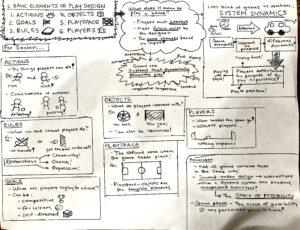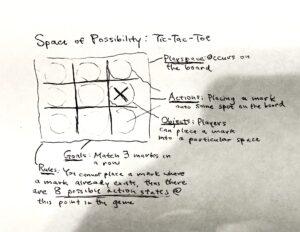Games, Design and Play: Elements
Sketchnote

Exercises
Identify the basic elements in a game of your choice (actions, goals, rules, objects, playspace, players).
Smash Ultimate
- Actions: Players can input buttons which correspond to in-game actions: the primary action set are the buttons which correspond to normal / special attacks / jump, combined with the directional input of a control stick. The set of in-game actions is the same for each character, but the properties of each move differs for each character. Characters can either move, jump, block, or throw out attacks based on what combination of inputs are given. There are also more subtle actions like shorter jump heights, drifting while in the air, tilting the angle of shield while blocking, and character-specific states like the Inkling’s ink recharge.
- Goals: The goal of each game of Smash is to be the winner – the rules that determine which player wins is something that can be changed from round to round.
- Rules: Players are given the choice to change the rules . This can include being the player who eliminates the most other players, the player who is the last one standing, etc. There are a few rules that do not change for the most part – being knocked off the stage
- Objects: The objects of the game include the playable characters of the game, the randomly spawning items that can be picked up and used, and the stage that the players are fighting on.
- Playspace: Within the context of the game world, the playspace occurs within the bounds of the stage, which are defined by the platforms that make up the stage itself, and a rectangular box which defines the boundaries of where players are considered ‘knocked out’. Outside the game, the playspace can occur in a common physical space where all players are physically present sharing the same screen, or across a long distance through online play.
- Players: Smash Ultimate supports anywhere from 1-8 players, and also allows players to play against computer controlled players.
One part of this exercise that’s incredibly interesting, especially with regards to Smash is that the game is incredibly flexible and customizable. You can generate many types different games by tweaking the goals and the rules, and the actions / interactions that are built into the game (e.g, the attacks and the movement) can support them. You can even make games inside Smash Ultimate that have nothing to do with combat – there are custom maps like ‘Smashketball’ which leverage the fighting game mechanics to allow for wildly different forms of gameplay (in this case, using hits to propel a ball into an opponent’s goal).
As a thought experiment, swap one element between two games: a single rule, one action, the goal, or the playspace. For example, what if you applied the playspace of chess to basketball? Imagine how the play experience would change based on this swap.
An interesting thought experiment would be applying the goal of a racing game like Trackmania of traversing the space as quickly as possible to a game like What Remains of Edith Finch. The environments, slow walking pace, and focus on storytelling in Edith Finch incentivize the player to explore and investigate to try and figure out the mystery being presented, and the overall goal is to learn more. By changing the goal to be about speed, players are incentivized to skip over all the narrative elements and the story, and because the walking/movement system of the game is not particularly complex, it would essentially destroy the play experience of the game, as the bulk of the game would be skipped and ignored.
Pick a real-time game and a turn-based game. Observe people playing each. Make a log of all the game states for each game. After you have created the game state logs, review them to see how they show the game’s space of possibility and how the basic elements interact.
Starcraft II – It’s difficult to exactly write down ‘all the game states’, but here is a list of all the variables at play at any point in time in the game
- How much of the map is visible (fog of war)
- Resources amounts (minerals / gas)
- Supply (# of currently used supply vs. maximum supply cap)
- Current units, buildings, and upgrades being produced
- # of worker units
- # of army units
- Composition of army units
- Positioning of army units both with respect to the map and with respect to each other
- Incomplete knowledge of opponent’s game state
Chess
- Piece positions for both player and opponent
- Check / checkmates
- What pieces can move, and where
Pick a simple game you played as a child. Try to map out its space of possibility, taking into account the goals, actions, objects, rules, and playspace as the parameters inside of which you played the game. The map might be a visual flowchart or a drawing trying to show the space of possibility on a single screen or a moment in the game.
Space of possibility in Tic-Tac-Toe


